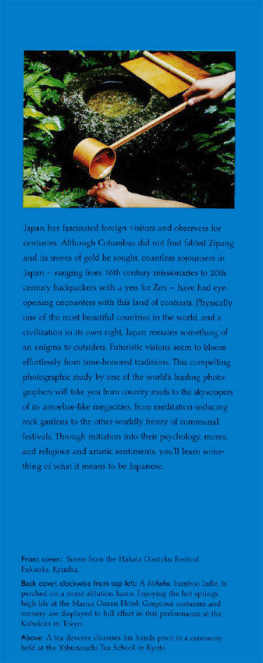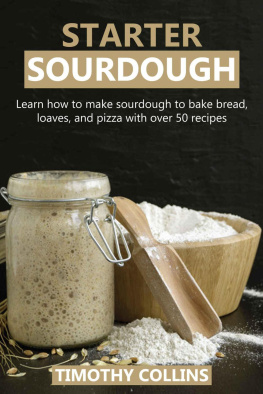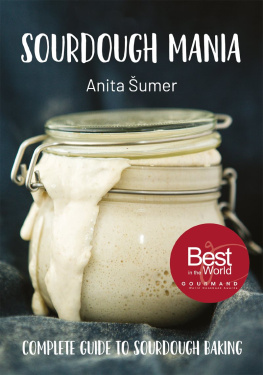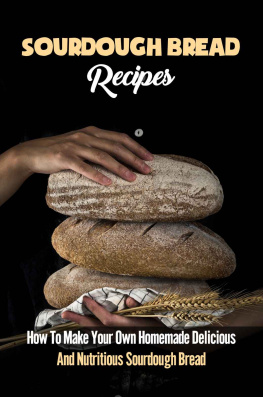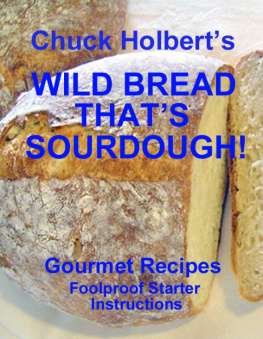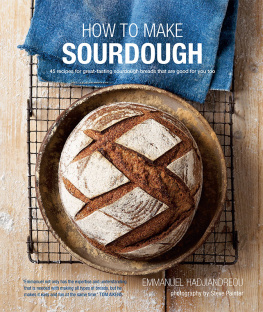John Carroll - Sourdough Bread Made Easy
Here you can read online John Carroll - Sourdough Bread Made Easy full text of the book (entire story) in english for free. Download pdf and epub, get meaning, cover and reviews about this ebook. year: 2014, genre: Home and family. Description of the work, (preface) as well as reviews are available. Best literature library LitArk.com created for fans of good reading and offers a wide selection of genres:
Romance novel
Science fiction
Adventure
Detective
Science
History
Home and family
Prose
Art
Politics
Computer
Non-fiction
Religion
Business
Children
Humor
Choose a favorite category and find really read worthwhile books. Enjoy immersion in the world of imagination, feel the emotions of the characters or learn something new for yourself, make an fascinating discovery.

- Book:Sourdough Bread Made Easy
- Author:
- Genre:
- Year:2014
- Rating:3 / 5
- Favourites:Add to favourites
- Your mark:
- 60
- 1
- 2
- 3
- 4
- 5
Sourdough Bread Made Easy: summary, description and annotation
We offer to read an annotation, description, summary or preface (depends on what the author of the book "Sourdough Bread Made Easy" wrote himself). If you haven't found the necessary information about the book — write in the comments, we will try to find it.
Sourdough Bread Made Easy — read online for free the complete book (whole text) full work
Below is the text of the book, divided by pages. System saving the place of the last page read, allows you to conveniently read the book "Sourdough Bread Made Easy" online for free, without having to search again every time where you left off. Put a bookmark, and you can go to the page where you finished reading at any time.
Font size:
Interval:
Bookmark:
Copyright 2014 John CarrollAll rights reserved.
ISBN: 1495363910
5: Kneading and Proving11
Sourdough bread is produced from three simple ingredients: flour, water andsalt. It does not require the addition of commercial yeast as the sourdoughprocess forms its own naturally occurring yeast in the sourdough culture. Thishas two consequences: first the bread is pure and natural and second, due tothe acidity of the sourdough culture, the bread has a distinctive sour doughtaste.
Once people have tasted proper sourdough bread there is often no goingback to commercial yeast-raised bread. However, because of the time it takesto make, it is more expensive in shops than commercially-produced yeastbread and consequently not so widely available. This has led to a growingnumber of people opting to produce their own sourdough bread. Although ittakes a bit more time overall, there is very little extra work involved than inbaking ordinary yeast bread, so if planned properly it can require little or noadditional effort.
I began making my own bread a few years back, first using a bread machineand then by hand. I produced wholemeal and mixed grain bread along withFrench baguettes and pizzas. All produced using dried yeast with good resultsbut I always had a yearning to try sourdough bread. Two things put me off:the many conflicting methods and the need to produce a sourdough starterbefore being able to make sourdough bread. It all sounded a bit tricky andtime consuming but I was wrong, it turned out to be simplicity itself!
But before I discovered that I read a lot of books and on-line referencematerial, which only made matters worse. Everyone had their own methodsand recipes and they then confused the issue by talking about hydration andall sorts of other technical jargon. Which brings me to the purpose of thisbook. My background is project management consultancy and over the pastfifteen or so years I have written a number of technical guides for the In EasySteps series. The whole purpose of that series is to make complicated subjectseasy to follow and that, I realized, was what was missing from sourdoughbread making, hence in this book I have tried to keep everything as simpleand easy to follow as possible.
With that in mind the chapters in this book are quite short and each onefocuses on a single topic, which is then covered in simple steps, with plenty ofillustrations.
Chapter 2 consists of a very brief history of sourdough bread and some of thetechnicalities behind it if you are interested in them, but please feel free toskip it if not.
When I finally got started on producing sourdough bread, I tried out all thevarious methods and recipes, with varying degrees of success, until I finallyhit on a method that works perfectly every time. That method not onlyguarantees success, it is simplicity itself. However it does require time so whatif you need to make some bread in a hurry?
There are two options: cheat and add some dried yeast to the sourdoughbread mix to give it a helping hand; or use baking soda to make soda breadinstead, it makes a nice change. I have included a recipe for quick sourdoughbread (with the addition of dried yeast) which doesnt taste bad but is not asgood as the real thing. My own preferred solution is to make soda bread. Itnot only tastes great but it takes less than an hour from start to finish. So Ihave also included a basic soda bread recipe as well.
The first part of the book covers the sourdough methods, processes, toolsand techniques. The second part of the book features a series of recipes usingdifferent methods and ingredients, followed by an ingredient calculator inboth metric and imperial to allow you to pick the size of loaf you want to make and a series of references and links to other sourdough bread resourcesand suppliers.
Backing this book up I also publish a blog called Sourdough Adventures(sourdougheasy.blogspot.co.uk) where I am always happy to receive feedbackand questions.
So happy reading and, more importantly, happy sourdough bread making.In order to have the correct texture, bread dough needs to leaven (rise andbecome aerated). Commercial bakers use bakers yeast and home bakerstypically use dried yeast. While this can produce a good texture (crumb) it canoften be a little lacking in flavor. Sourdough bread on the other hand doesnot require the addition of any other yeast and it also has a great flavor.
Sourdough bread has been around for a long time and is thought to haveoriginated in ancient Egypt around 1500 BC. In fact sourdough was the normal way of leavening bread until the middle ages when it started beingreplaced by yeast from the brewing process. Later still came the developmentof bakers yeast and you might say it all went downhill from there!
Sourdough was the main bread made during the California Gold Rush, and itstill remains a part of the culture of San Francisco today. The bread becameso common that "sourdough" became a general nickname for the goldprospectors. Although sourdough bread wassuperseded in commercialbakeries in the 20th century, it has undergone a revival among artisan bakersin recent years.
All sourdough bread starts with a sourdough culture or starter. Sourdoughstarters are used all over the world and they are always handled in a similarway. The baker never uses all of the starter. Each time they use some of thestarter to make a loaf or batch of bread, the remainder is refreshed with flourand water and saved for the next baking session. In this way the starter ismaintained and effectively lasts forever. There are some bakers I have heardof that are still using starters first produced by their great-grandparents oreven earlier generations.
A sourdough starter is a mixture of wild yeast and lactobacillus bacteria, living in a mixture of flour and water. The yeast and lactobacillus bacteria form asymbiosis that is interesting and makes the culture quite stable. The yeastproduces the carbon dioxide gas that leavens or aerates the dough, while thelactobacillus makes the culture acidic. The acidity also acts as an antibiotic,keeping stray bacteria and yeast out. Few yeast strains can survive in asourdough culture but those that can survive the acidity produced by thelactobacillus will thrive. The lactobacillus also eat the dead yeast cells, whichhelps keep the culture from getting nasty. When compared to breads madewith baker's yeast, the sourdough starter produces a mildly sour taste becauseof the lactic acid produced by the lactobacilli. This is what gives sourdoughbread its distinct taste.
Incidentally, bread made from rye flour, is nearly always leavened with sourdough or baking soda. Baker's yeast is not a good leavening agent for ryebread, as rye flour does not contain enough gluten for it to act on.
Anyway enough about history, lets look at the basic sourdough process, itprobably hasnt changed since the ancient Egyptians developed it and itconsists of just four steps:
Step 1: produce the sourdough starterStep 2: mix the ingredients to form the dough
Step 3: knead the dough and leave it to prove
Step 4: bake the bread and leave it to cool
The final three steps are exactly the same as baking with bakers yeast, theonly difference is that the proving time is much longer (typically six to twelvehours rather than two hours). The longer proving time is because the naturalyeast in the sourdough takes longer to prove than commercial bakers yeastbut thats what gives it such a great taste.
The next four chapters will expand on each of the four steps above, in a series of simple and easy steps (with plenty of illustrations), starting withproducing the sourdough starter.
Font size:
Interval:
Bookmark:
Similar books «Sourdough Bread Made Easy»
Look at similar books to Sourdough Bread Made Easy. We have selected literature similar in name and meaning in the hope of providing readers with more options to find new, interesting, not yet read works.
Discussion, reviews of the book Sourdough Bread Made Easy and just readers' own opinions. Leave your comments, write what you think about the work, its meaning or the main characters. Specify what exactly you liked and what you didn't like, and why you think so.


